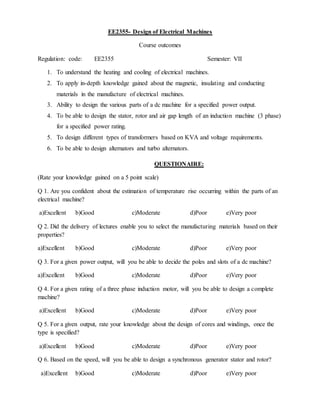Uma ee2355 design of electrical machines
- 1. EE2355- Design of Electrical Machines Course outcomes Regulation: code: EE2355 Semester: VII 1. To understand the heating and cooling of electrical machines. 2. To apply in-depth knowledge gained about the magnetic, insulating and conducting materials in the manufacture of electrical machines. 3. Ability to design the various parts of a dc machine for a specified power output. 4. To be able to design the stator, rotor and air gap length of an induction machine (3 phase) for a specified power rating. 5. To design different types of transformers based on KVA and voltage requirements. 6. To be able to design alternators and turbo alternators. QUESTIONAIRE: (Rate your knowledge gained on a 5 point scale) Q 1. Are you confident about the estimation of temperature rise occurring within the parts of an electrical machine? a)Excellent b)Good c)Moderate d)Poor e)Very poor Q 2. Did the delivery of lectures enable you to select the manufacturing materials based on their properties? a)Excellent b)Good c)Moderate d)Poor e)Very poor Q 3. For a given power output, will you be able to decide the poles and slots of a dc machine? a)Excellent b)Good c)Moderate d)Poor e)Very poor Q 4. For a given rating of a three phase induction motor, will you be able to design a complete machine? a)Excellent b)Good c)Moderate d)Poor e)Very poor Q 5. For a given output, rate your knowledge about the design of cores and windings, once the type is specified? a)Excellent b)Good c)Moderate d)Poor e)Very poor Q 6. Based on the speed, will you be able to design a synchronous generator stator and rotor? a)Excellent b)Good c)Moderate d)Poor e)Very poor
- 2. Electrical Machines II New regulation: code:EE6504 Semester: V Old regulation: code: EE2302 Semester: V Course outcomes 1. To apply the knowledge of construction, working and types of synchronous machines and the principle associated with emf generation 2. To predetermine the regulation of to synchronous generators and develop the equivalent circuit of alternators. 3. To understand the basic concepts, starting methods and characteristics of synchronous motors. 4. To predetermine the performance of three phase induction motors, understand the methods of starting employed for three phase induction motors. 5. To gain knowledge about the different methods of speed control. 6. To gain knowledge about equivalent circuit on the basis of double field revolving theory, starting methods adopted and to estimate the performance parameters from predetermination tests. Questionnaire: Q 1. Does the lecture on synchronous generators provide sufficient information about the emf induced? a)Excellent b)Good c)Moderate d)Poor e)Very poor Q 2. Are you aware of the different methods adopted for the predetermination of regulation of a synchronous alternator? a)Excellent b)Good c)Moderate d)Poor e)Very poor Q 3. Will you be able to calculate the back emf at different loads and load power factors? a)Excellent b)Good c)Moderate d)Poor e)Very poor Q 4. How will you rate the delivery of lectures on three phase induction motors? Will you be able to calculate the different torques associated with these motors? a)Excellent b)Good c)Moderate d)Poor e)Very poor Q 5. Rate the understanding gained on starting methods and speed control of three phase induction motors on a five point scale. a)Excellent b)Good c)Moderate d)Poor e)Very poor Q 6. Will you be able to develop the equivalent circuit of single phase induction motor? a)Excellent b)Good c)Moderate d)Poor e)Very poor


